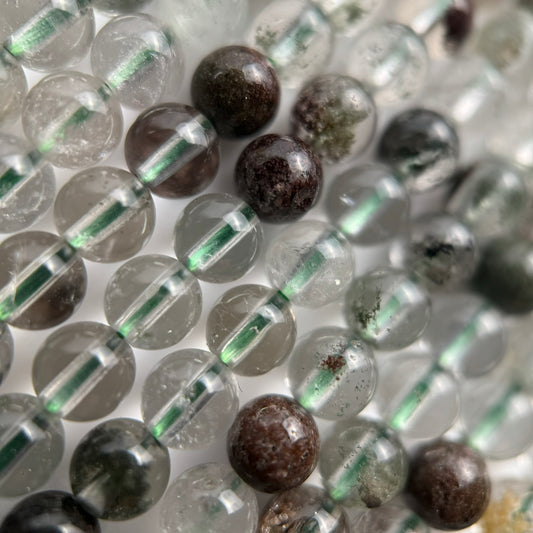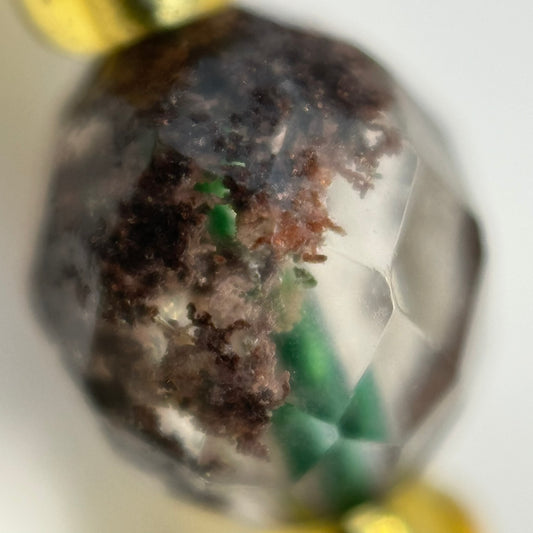Lodalite Gemstone Beads
Understanding Lodalite Gemstone Beads
Lodalite is a rare variety of quartz characterized by its distinctive inclusions and patterns. This unique gemstone displays interesting visual properties that make it appealing for collectors and jewelry designers seeking unusual materials.
Unique Features
- Distinctive inclusion patterns
- Quartz base with various inclusions
- Unique visual characteristics
- Mohs hardness of 7
- Rare and collectible
Mineralogical Composition
Lodalite consists primarily of silicon dioxide (SiO2) with various mineral inclusions that create its distinctive appearance. The exact composition can vary between specimens.
Composition Details
- Base mineral: Quartz (SiO2)
- Various mineral inclusions
- Crystal system: Trigonal
- Specific gravity: 2.65-2.80
- Refractive index: 1.544-1.553
Formation and Geological Processes
Lodalite forms through geological processes that create unique inclusion patterns within quartz. These processes occur over extended periods under specific conditions.
Formation Conditions
- Quartz crystallization environments
- Inclusion capture during growth
- Specific geological conditions
- Extended formation periods
- Unique mineral availability
Inclusion Patterns and Visual Appeal
The inclusions in Lodalite create various patterns that enhance its visual interest. Each specimen displays unique characteristics.
Pattern Types
- Various inclusion patterns
- Unique visual characteristics
- Pattern variations between specimens
- Interesting color combinations
- Distinctive appearance
Color Variations
Lodalite displays various colors depending on the inclusions present. The base quartz may be transparent to translucent with colored inclusions.
Color Characteristics
- Base quartz color variations
- Inclusion-related colors
- Pattern-dependent appearance
- Unique color combinations
- Variations between specimens
Cutting and Processing
Proper cutting maximizes Lodalite's visual appeal while maintaining the integrity of inclusions. Orientation affects how patterns are displayed.
Cutting Considerations
- Orientation affects pattern visibility
- Faceted or cabochon cuts
- Bead shapes showcase patterns
- Polish enhances appearance
- Careful handling required
Hardness and Durability
With a Mohs hardness of 7, Lodalite offers good durability for jewelry use. The quartz base provides stability.
Durability Aspects
- Mohs hardness: 7
- Good resistance to scratching
- Stable under normal conditions
- No cleavage planes
- Suitable for jewelry
Geographic Sources
Lodalite occurs in limited locations, making it a rare and collectible material. Specific sources may vary.
Source Information
- Limited geographic distribution
- Rare occurrence
- Collector interest
- Variable availability
- Unique specimens
Care and Maintenance
Lodalite requires standard quartz care practices. Proper cleaning and storage maintain its appearance.
Care Guidelines
- Clean with warm soapy water
- Soft brush for detailed cleaning
- Store separately
- Standard jewelry care
- Protect from impacts
Jewelry Design Possibilities
Lodalite beads offer unique design opportunities for collectors and designers seeking distinctive materials.
Design Applications
- Collector pieces
- Unique jewelry designs
- Showcase distinctive patterns
- Combinations with other stones
- Special occasion jewelry
Collectibility and Value
Lodalite's rarity and unique appearance contribute to its collectibility and value among gemstone enthusiasts.
Value Factors
- Rarity increases value
- Unique patterns desirable
- Collector interest
- Limited availability
- Distinctive appearance
Identification and Authentication
Proper identification of Lodalite requires knowledge of its specific characteristics. Professional assessment may be helpful.
Identification Methods
- Visual examination of patterns
- Hardness testing
- Specific gravity measurement
- Professional gemological assessment
- Comparison with similar materials
Frequently Asked Questions
What is the mineralogical composition and crystal structure of Lodalite?
Lodalite is a rare variety of quartz (SiO2) that contains inclusions of various minerals, primarily feldspar and other silicates. It's classified as a cryptocrystalline quartz variety, similar to agate, but with distinctive internal patterns and colorations that result from its unique mineral inclusions.
What causes the distinctive patterns and colors in Lodalite beads?
The patterns in Lodalite result from the distribution and composition of mineral inclusions within the quartz matrix. These inclusions can include feldspar, mica, or other silicate minerals that create banding, clouding, or dendritic patterns. The colors vary based on the type and oxidation state of the included minerals.
What is the Mohs hardness and durability of Lodalite gemstone beads?
Lodalite maintains the Mohs hardness of 7, characteristic of all quartz varieties. However, the presence of inclusions may create planes of weakness that could affect toughness. The overall durability is good for jewelry use, though care should be taken to avoid impacts that could cause fracturing along inclusion boundaries.
How does Lodalite differ from other quartz varieties like Agate or Jasper?
Lodalite differs from agate in its inclusion types and patterns—it typically contains feldspar and silicate inclusions rather than the chalcedony layers found in agate. Unlike jasper, which is opaque, Lodalite can be translucent to semi-translucent, allowing light to interact with internal inclusions creating depth and visual interest.
What are the primary geological sources and formation environments of Lodalite?
Lodalite forms in hydrothermal environments where silica-rich solutions interact with feldspar-rich host rocks. It's found in limited locations, with notable sources including certain regions in Brazil and Madagascar. The formation requires specific conditions where quartz crystallization occurs simultaneously with or after the inclusion of other minerals.
What is the specific gravity and how does it compare to pure quartz?
Lodalite has a specific gravity slightly higher than pure quartz (2.65), typically ranging from 2.66 to 2.68, depending on the type and concentration of inclusions. The denser mineral inclusions (feldspar has SG ~2.6-2.7) contribute to this slight increase, though the difference is usually not noticeable in beads.
How do the mineral inclusions affect the optical properties of Lodalite beads?
The inclusions in Lodalite create unique optical effects including light scattering, color variations, and sometimes chatoyancy or asterism if the inclusions are aligned. The translucency allows light to penetrate and interact with internal structures, creating depth and visual complexity not found in opaque quartz varieties.
What cutting and polishing considerations are important for Lodalite beads?
Cutters must orient Lodalite to maximize the display of internal patterns and inclusions. The material should be cut to showcase the most interesting inclusions while avoiding planes of weakness. Polishing requires care to avoid removing material that contains important inclusions, and the surface finish should enhance the translucency and internal patterns.
Can Lodalite beads exhibit optical phenomena like chatoyancy or asterism?
Yes, some Lodalite specimens can exhibit chatoyancy (cat's eye effect) or asterism (star effect) if the inclusions are aligned in parallel or radial patterns. These optical phenomena are less common than in other quartz varieties but can occur when specific inclusion types and orientations are present.
How should Lodalite beads be cleaned and maintained?
Clean Lodalite beads with warm, soapy water and a soft cloth. Avoid harsh chemicals, ultrasonic cleaners, or steam cleaning that could affect the inclusions or cause fracturing along inclusion boundaries. Store separately from harder materials to prevent scratching, and protect from impacts.
What causes the variation in pattern types among different Lodalite beads?
Pattern variations result from differences in inclusion types, distribution, and the timing of inclusion formation relative to quartz crystallization. Some specimens show banding (from sequential growth), while others show dendritic patterns (from mineral replacement) or cloud-like inclusions (from simultaneous crystallization).
How do gemologists identify and verify authentic Lodalite beads?
Gemologists identify Lodalite through its quartz properties (hardness 7, specific gravity ~2.66-2.68), combined with microscopic examination of inclusions. The presence of feldspar and silicate inclusions within a quartz matrix, along with the characteristic patterns, helps distinguish it from other quartz varieties and synthetic materials.
What makes Lodalite beads unique compared to other included quartz varieties?
Lodalite is unique due to its specific combination of feldspar and silicate inclusions within quartz, creating distinctive patterns and optical effects. Its translucency allows for depth and visual complexity, while the inclusion types and distributions create patterns that are characteristic of this rare quartz variety.
How does the quality of inclusions affect the value of Lodalite beads?
High-quality Lodalite beads feature well-distributed, interesting inclusions that create attractive patterns without compromising durability. The inclusions should enhance the visual appeal rather than create excessive clouding or fractures. Specimens with chatoyancy, asterism, or particularly striking patterns command higher values.
What environmental factors can affect Lodalite beads over time?
Lodalite is relatively stable, but prolonged exposure to acids or harsh chemicals could potentially affect the included minerals. Thermal shock should be avoided as it could cause fracturing along inclusion boundaries. Under normal jewelry-wearing conditions, Lodalite beads maintain their appearance well with proper care.





